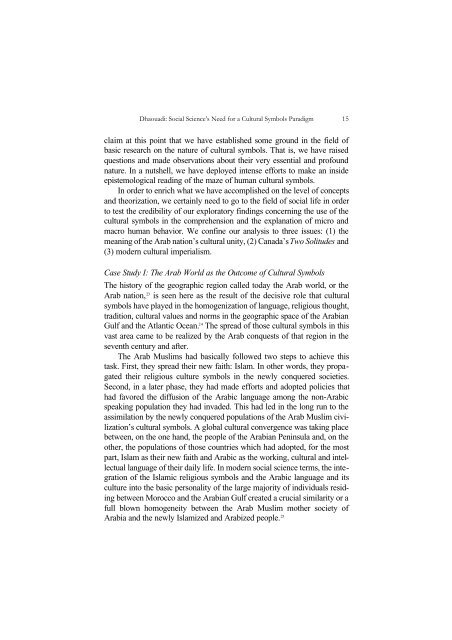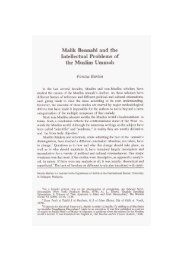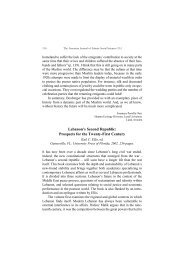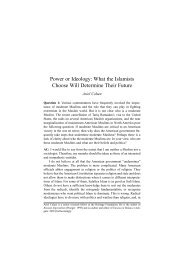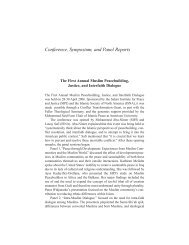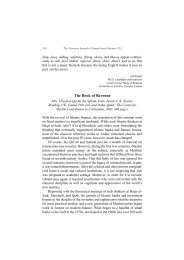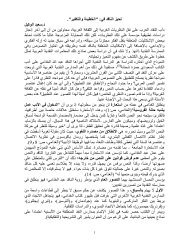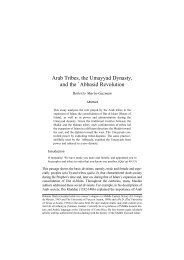Social Science's Need for a Cultural Symbols ... - Epistemology
Social Science's Need for a Cultural Symbols ... - Epistemology
Social Science's Need for a Cultural Symbols ... - Epistemology
You also want an ePaper? Increase the reach of your titles
YUMPU automatically turns print PDFs into web optimized ePapers that Google loves.
Dhaouadi: <strong>Social</strong> Science’s <strong>Need</strong> <strong>for</strong> a <strong>Cultural</strong> <strong>Symbols</strong> Paradigm 15<br />
claim at this point that we have established some ground in the field of<br />
basic research on the nature of cultural symbols. That is, we have raised<br />
questions and made observations about their very essential and profound<br />
nature. In a nutshell, we have deployed intense ef<strong>for</strong>ts to make an inside<br />
epistemological reading of the maze of human cultural symbols.<br />
In order to enrich what we have accomplished on the level of concepts<br />
and theorization, we certainly need to go to the field of social life in order<br />
to test the credibility of our exploratory findings concerning the use of the<br />
cultural symbols in the comprehension and the explanation of micro and<br />
macro human behavior. We confine our analysis to three issues: (1) the<br />
meaning of the Arab nation’s cultural unity, (2) Canada’s Two Solitudes and<br />
(3) modern cultural imperialism.<br />
Case Study I: The Arab World as the Outcome of <strong>Cultural</strong> <strong>Symbols</strong><br />
The history of the geographic region called today the Arab world, or the<br />
Arab nation, 23 is seen here as the result of the decisive role that cultural<br />
symbols have played in the homogenization of language, religious thought,<br />
tradition, cultural values and norms in the geographic space of the Arabian<br />
Gulf and the Atlantic Ocean. 24 The spread of those cultural symbols in this<br />
vast area came to be realized by the Arab conquests of that region in the<br />
seventh century and after.<br />
The Arab Muslims had basically followed two steps to achieve this<br />
task. First, they spread their new faith: Islam. In other words, they propagated<br />
their religious culture symbols in the newly conquered societies.<br />
Second, in a later phase, they had made ef<strong>for</strong>ts and adopted policies that<br />
had favored the diffusion of the Arabic language among the non-Arabic<br />
speaking population they had invaded. This had led in the long run to the<br />
assimilation by the newly conquered populations of the Arab Muslim civilization’s<br />
cultural symbols. A global cultural convergence was taking place<br />
between, on the one hand, the people of the Arabian Peninsula and, on the<br />
other, the populations of those countries which had adopted, <strong>for</strong> the most<br />
part, Islam as their new faith and Arabic as the working, cultural and intellectual<br />
language of their daily life. In modern social science terms, the integration<br />
of the Islamic religious symbols and the Arabic language and its<br />
culture into the basic personality of the large majority of individuals residing<br />
between Morocco and the Arabian Gulf created a crucial similarity or a<br />
full blown homogeneity between the Arab Muslim mother society of<br />
Arabia and the newly Islamized and Arabized people. 25


